British Toy Companies : CHAD VALLEY TOYS
CHAD VALLEY TOYS
This long established British toy company has its roots set in a stationery business set up by Joseph and Alfred Johnson (Johnson Bros.) in 1860 on George Street, in Birminghams’ city centre although its origins date back even further to a printing and book binding business set up by their father Anthony Bunn Johnson sometime around 1820.
In 1897 the company relocates to a new purpose built premises in Rose Road, Harborne, a district of Birmingham,  a mere 3 miles from the city centre close to the Chad Brook and adjacent to
a mere 3 miles from the city centre close to the Chad Brook and adjacent to
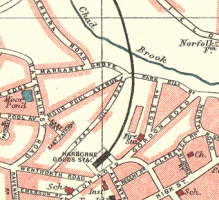 ..
..
.
.
.
.
.
.
.
.a branch-line railway. This railway line brought raw materials to the site with most of the toys produced leaving by the same route. The firm now trading as Johnson Bros. (Harborne) Ltd., making stationers’ sundries and cardboard games and their new factory was known as The Chad Valley Works, named after the nearby stream. They later took the name of Chad Valley as their registered trademark and the building was to remain as the company headquarters for over seventy years.
With the outbreak of the First World War in 1914 toys and games were no longer being  imported giving a boost to the British toy industry and Johnson Bros. seized the opportunity, despite wartime restrictions, to expand its range of cardboard games and simple toys. A year later in 1915 the company was producing its first soft toys, a range of traditional plush Teddy Bears with jointed limbs and by 1916 it was to patent a machine for stuffing these soft toys.
imported giving a boost to the British toy industry and Johnson Bros. seized the opportunity, despite wartime restrictions, to expand its range of cardboard games and simple toys. A year later in 1915 the company was producing its first soft toys, a range of traditional plush Teddy Bears with jointed limbs and by 1916 it was to patent a machine for stuffing these soft toys.
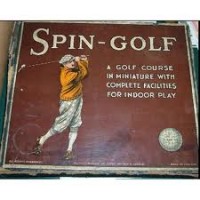 In these early days the companys aim was to complement the range of paper and card based products, which had been born out of their printing business, with more ambitious toys using different materials however a strong emphasis on the printed word remained and at a time when it was unusual for most ‘ordinary’ children to be given toys it was little wonder that output was targeted squarely towards affluent families with their well educated children.
In these early days the companys aim was to complement the range of paper and card based products, which had been born out of their printing business, with more ambitious toys using different materials however a strong emphasis on the printed word remained and at a time when it was unusual for most ‘ordinary’ children to be given toys it was little wonder that output was targeted squarely towards affluent families with their well educated children.
Such was the rate of the companys’ expansion since the early war years 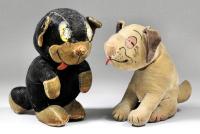 that in 1919 it was to acquire the nearby Harborne Village Institute which was used as their printing works producing box covers and labels for their toys and games. The companys’ soft toy production was relocated in 1920 to a new factory, the Wrekin Toy Works, at Wellington, Shropshire, where a new range of fabric dolls were introduced and all three factories were merged to become The Chad Valley Co. Ltd. In that same year both the Wellington and Harborne works were extended as business continued to increase.
that in 1919 it was to acquire the nearby Harborne Village Institute which was used as their printing works producing box covers and labels for their toys and games. The companys’ soft toy production was relocated in 1920 to a new factory, the Wrekin Toy Works, at Wellington, Shropshire, where a new range of fabric dolls were introduced and all three factories were merged to become The Chad Valley Co. Ltd. In that same year both the Wellington and Harborne works were extended as business continued to increase.
![]() The soft toy range they produced all carried a sew-in label, well known by collectors of today, with most reading ‘Hygienic Toys / Made in England / Chad Valley Co. or Chad Valley Co. Ltd.’ some simply ‘Hygienic Toys England’.
The soft toy range they produced all carried a sew-in label, well known by collectors of today, with most reading ‘Hygienic Toys / Made in England / Chad Valley Co. or Chad Valley Co. Ltd.’ some simply ‘Hygienic Toys England’.
In 1922 Chad Valley was a Listed Exhibitor at the British Industries Fair (Stand F.35) Indoor Games, Puzzles, 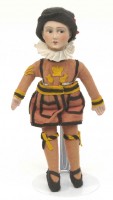 Christmas Crackers and Stockings, Toys of all Description including Playing Balls, Teddy Bears, Fabric Dolls and other Soft Toys, Rattles, Mascots etc. Interestingly enough they also featured (Stand Nos. K.35 and K.60) Listed as Manufacturers of Stationers’ Carded Sundries and Fancy Goods, Labels and Tickets, Office Appliances, Motorists’ Trunks, Fur Rugs and Gauntlets, Picnic Cases.
Christmas Crackers and Stockings, Toys of all Description including Playing Balls, Teddy Bears, Fabric Dolls and other Soft Toys, Rattles, Mascots etc. Interestingly enough they also featured (Stand Nos. K.35 and K.60) Listed as Manufacturers of Stationers’ Carded Sundries and Fancy Goods, Labels and Tickets, Office Appliances, Motorists’ Trunks, Fur Rugs and Gauntlets, Picnic Cases.
Further expansion took place again in 1928 with a new factory adjoining the main works at Harborne, and again in 1932 with the acquisition of the long established London toy making firm of Peacock & Company which added new capabilities and allowed them to offer tinplate products, including toy cars and clockwork train sets.
During the 1920’s and 1930’s the Wrekin toy works produced a steady stream of new dolls, these dolls were dressed in authentic materials and Chad Valley even brought out several boy dolls suitably attired in tweed sports jackets with felt collars, neck ties and of course the obligatory gun bag as befits the children of the country squire. It was this attention to detail which set them apart from the competition but they were not cheap, typically selling for somewhere between 5/- and 30/- which would equate to around £20 – £100 in todays money.
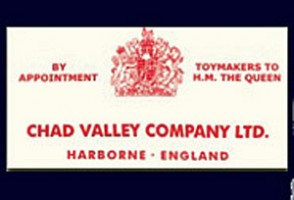 In 1938 Chad Valley were granted the prestigeous Royal Warrant of Appointment – ‘Toymakers to Her Majesty the Queen’, a relatively rare honour for a toy maker at this time. This may have had something to do with the fact that earlier in a bold move the Palace had been approached by Chad Valley executives for permission to produce dolls of the Royal Princesses, Elizabeth and Margaret Rose. It was with some surprise that the company received a note back from the Queen agreeing to the proposal along with suggested dates for the two princesses to sit for the proposed dolls. Fortunately for Chad Valley the dolls proved an instant hit, selling in large numbers not only at home but right across the then British Empire and so for the next fourteen years all Chad Valley toys carried the words ‘Toymakers to H.M. The Queen’. This was later amended to ‘Toymakers to H.M. Queen Elizabeth the Queen Mother’ when Princess Elizabeth acceded to the throne in 1952.
In 1938 Chad Valley were granted the prestigeous Royal Warrant of Appointment – ‘Toymakers to Her Majesty the Queen’, a relatively rare honour for a toy maker at this time. This may have had something to do with the fact that earlier in a bold move the Palace had been approached by Chad Valley executives for permission to produce dolls of the Royal Princesses, Elizabeth and Margaret Rose. It was with some surprise that the company received a note back from the Queen agreeing to the proposal along with suggested dates for the two princesses to sit for the proposed dolls. Fortunately for Chad Valley the dolls proved an instant hit, selling in large numbers not only at home but right across the then British Empire and so for the next fourteen years all Chad Valley toys carried the words ‘Toymakers to H.M. The Queen’. This was later amended to ‘Toymakers to H.M. Queen Elizabeth the Queen Mother’ when Princess Elizabeth acceded to the throne in 1952.
Around the 1939-1940 period Chad Valley acquired the tooling of tinplate toymakers 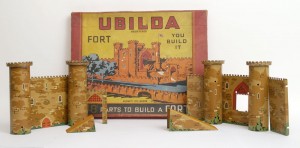 Burnett of London who had got into financial difficulties and continued to manufacture many of that companys product lines well after the second world war probably the most well know of which was the ‘Ubilda’ tinplate model kits.
Burnett of London who had got into financial difficulties and continued to manufacture many of that companys product lines well after the second world war probably the most well know of which was the ‘Ubilda’ tinplate model kits.
War, sadly again, played a part in the fortunes of the company in the 1940’s. The Second World War resulted in production of toys being dramatically cut as the Chad Valley factories concentrated their output to the war effort with government contracts for the production of such items as wooden instrument cases and cases for use in anti-aircraft guns, hospital tables and tent poles, auto-pilots and charts. However one factory was retained by the government for toy manufacture, specialising in the production of jigsaws, chess sets, draughts and dominoes for use in military hospitals and the Forces generally.
With the ending of the war the Chad Valley factories quickly returned to toy production and the company went from strength to strength adding both metal and rubber toys to their range. In 1950 it stopped being a family business and became a public limited company.
Over the next ten years or so they go on to expand by acquiring several companies including in 1951 the metal toy manufacturers of Hall and Lane, in 1954 the family business of Robert Brothers (Gloucester) Ltd., trading as ‘Glevum’ Toys and in 1958 the metal toy makers Acme Stopper and Box Co. The Glevum range of toys and games were to be produced in Harborne at an additionally factory, the Wee-Kin Works, on the banks of the Chad. By 1960 Chad Valley comprised seven factories and employed over 1,000 people and was considered to be at its peak of manufacturing by this time.
H.G. Stone and Co. Ltd. ( Chiltern Toys ) was the final company to be taken over in 1967 despite Chad Valley beginning to feel the onset of stiff foreign competition and recession.
1971 saw the company sold to John Bentley of Barclay Securities for £600,000 who came with the reputation of streamlining and rationalising companies under his control. Within a year the sales catalogue now lists only 250 products half of which were new lines whilst the remainder had been updated and repackaged. The main Harborne factory closes and was eventually demolished and boxed game production moves to the Hall & Lane factory site in central Birmingham. Three out of the nine factories are to close with the resultant redundancies.
After 1975 only two factories remained whilst the manufacture of soft toys was relocated to Pontypool in South Wales.
In 1978 the company was taken over by Palitoy of Leicester and a year later in 1979 the closure of the Hall & Lane site ended Chad Valley’s long established links with Birmingham.
In 1988 the trade name of Chad Valley was acquired by Woolworths and remained in use until that company’s closure due to insolvency. Home Retail Group, the parent company of retailers Homebase and Argos, purchased the brand for a reputed £5 million in 2009. The Chad Valley brand is now available exclusively through Argos catalogues.
____
further examples of Chad Valley toys :
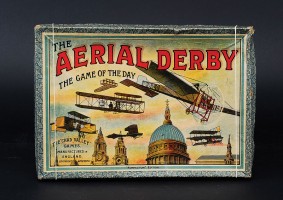 < THE AERIAL DERBY
< THE AERIAL DERBY
An excellently illustrated Chad Valley boxed board game manufactured c1912. The object of the game was to move, by means of a spinning dice, around the board starting at London and finishing at Windsor Castle travelling via such places and cities as Dublin, Montreal, Paris, Japan and New Zealand. Board has lovely illustrations of the sights of London and other cities and counters are in the form of early Bleriot type aircraft.
.
RACE TO THE OCEAN COAST >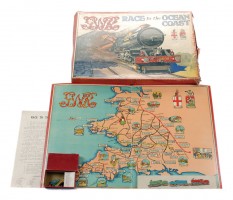
Dating to around the 1920’s is this Chad Valley GWR railway racing board game. An attractively illustrated board showing a map of Great Western railway tracks covering the West Country and Wales. Various metal locomotive and saloon car counters compete in this race to the coast.
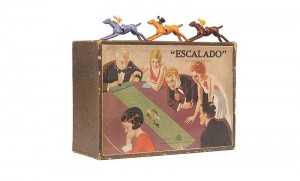
< ESCALADO
Without doubt the table top horse racing game of Escalado was one of those iconic games produced by Chad Valley. Introduced in 1928 the game was a constant best seller well into the 1960’s. Originally consisted of 5 lead race horses with jockeys, a green cloth fabric track with clamps and a mechanical winding mechanism along with a staking sheet on which one placed ones bets. Over the years the illustrated box top changed and reflected the decade, opposite shows a pre-war box lid.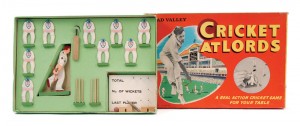
CRICKET AT LORDS >
Originally dating to the late 1940’s this Chad Valley game is a complete miniature table top game of cricket. Contains a bat, ball, pair of stumps, scoreboard and numbers, 9 fielders and a firing action bowler. The bowler figure is used by one player to toss a wooden ball at the wickets whilst the other player attempts to hit the ball into play avoiding the wooden fielders. Shown here is an illustration of the 1950’s version of the game.
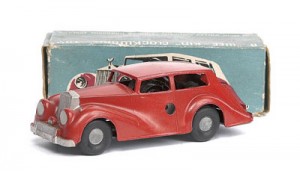 .
.
< RAZOR EDGE ROLLS ROYCE SALOON
Chad Valley ‘Wee-Kin’ motorised toy model of a Rolls Royce Razor Edge Saloon car. Diecast vehicle fitted with a key-wound clockwork motor produced between 1949-1953. Model came in various colouways in a card illustrated box at 1:43 scale.
.
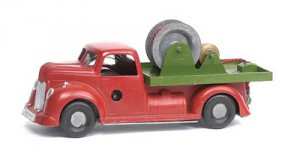
.
CABLE LAYER LORRY >
This Chad Valley clockwork driven toy comes as a cable laying vehicle, again produced around 1949 – 1953. Lorry came in red cab and chassis colourway finish with green bed mounted with a cable drum, coloured string acting as the cable.
.
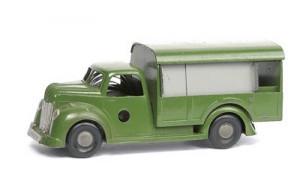 < VAN TYPE REFUSE WAGON
< VAN TYPE REFUSE WAGON
Wee-Kin van type refuse wagon, diecast clockwork model in van type configuration has green cab and body and fitted with grey tinplate sliding shutters. Again produced between 1949 – 1953.
Note : The first Wee-Kin diecast toy vehicles were produced around 1949 and had ‘CV 1949’ as the registration number.
I hope to cover the ‘Wee-Kin’ element of the Chad Valley range in more detail at a later date along with further images.

hi ive got a cricket game ..its a square field so it might be lords ..some of the players have names on thier backs ( RAY ..DAVID ..MAX…ROBERT…LOU…JOHN )…im trying to find out what it is from …if you can help me out that would good ….cheers
Peter, I do ‘DECLARE’ this cricket game of yours might have got me ‘STUMPED’, indeed you could say I’m in a bit of a ‘SPIN’ with this one, but before I admit to being completely ‘BOWLED’ ‘OVER’ by it I need to ask you for more details.
Is the pitch cloth ? does it have any markings on it ?
What are the players made of ? how many are there ? is there a bowler and ball ?
In fact as many new details as you can give may help.
Don’t know a cricket game that printed names on fielders backs and certainly having first names makes me think these have been put on by some enterprising youngster using his mates names. The manufacturers would I think have used the well known cricketers surnames of the day the likes of Compton, Sutcliffe, Hobbs, Cowdrey, Trueman etc.
Look forward to your reply, David.
hi ..ha ha you are a funny man good one …the whole pitch is cloth & so is the field ….it does have markings on it the board is rectangle not square & has 1..2..3…which ver out from the pitch..because the plastic players have pins from a metal base which go into there legs to hold them up …it is a tri-ange top cricket ..model no. rv.253….british patent no.884600……made in ENGLAND by rovex scale models limited….no date on it ..10 PLAYERS…& THE BALL IS LEAD ..WHICH IS ROLLED DOWN A SHOOT TO THE BATSMAN ….if you can help me that would helpful as i cant find anything like this in AUSTRALIA …..CHEERS MATE
Hi again Pete, struggling to find anything substantial for this game of yours. Tri-ang bought out the Rovex name in 1951 so its obviously after that date. The only definite thing I have is a full page advert from the Meccano Magazine which is for your game. This was shown in the May issue of 1967 so would assume rightly or wrongly that it must have been brought out around that year. You will see the price of the game is given .. not a cheap item by any means .. OWZAT .. best I can come up with at the moment. Got to go now missing us thrash the Aussies on SKY ! David.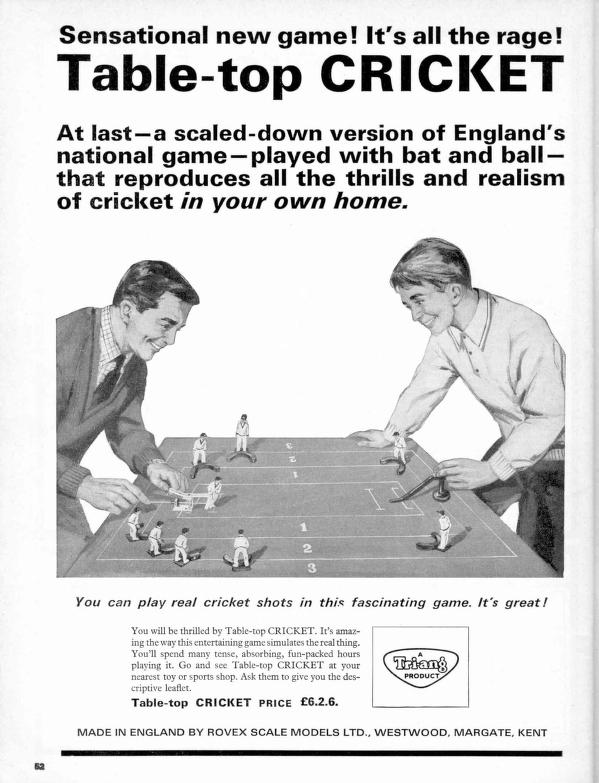
gidday mate ..yes the aussies are playing like a couple of girls …… the useless mongreals ..BUT that is definately the game ..you are a lengend …thank you very much ..im over the moon with the results you have given me …cheers mate
Glad to be of help .. and I can’t help the gloating re the cricket .. makes a change as your cricket lads would probably trounce our England football team ! David
Hello David
Just discovered your interesting and informative site. I have recently discovered my interest in old tinplate vehicles, especially early 20th C. I wonder if you could explain why some vehicles manufactured by Burnett or Wells seem to have been fetching such astronomical sums in recent auctions, even when they are offered in apparently very poor condition? Is it because all these items are relatively rare, or is it just certain models? E.g. two Burnett vehicles in a recent sale local to me (Chichester) made over £200 for the pair, although they were both in poor condition with parts missing.
Thanks for your advice, and best wishes, from another David
Hi there David,
An interesting question with a many faceted answer. Hard to be specific regarding the two items you refer to without knowing which specific models they were so I am going to generalise with my answer.
Burnett had a relatively short life – 1914 to 1939 ( I will do a short piece on them shortly with pics ) so the toys they produced are certainly in demand, dare I say regardless of condition ? Collectors are more than happy to purchase a distressed piece, restore and resell to an eager marketplace. As with any collectable, the harder it is to find then generally the greater the demand. The major toy auction sites may only offer a Burnett vehicle in decent condition half a dozen times in a year, compare that to the numerous Japanese tinplate models available at every sale.
Similarly Wells Brimtoy, (see my separate notes on the company), although producing vehicles over a longer period, its the earlier models which command the higher prices !
On the whole if one is collecting say early BRITISH tinplate vehicles then 1) the choice of manufacturer is severely limited and 2) the number of different models each company produced is similarly limited.
Too many collectors chasing too few items, hence the models carrying a premium price in comparison to lets say the more productive of the foreign manufacturers. However lets temper that a little by reminding ourselves that early German and French vehicle models are also commanding high prices. So generally speaking its the late 19th and early 20th century pieces, regardless of country of origin, that collectors are looking for and prepared to pay for.
Indeed this early period of tinplate toys is often referred to as the ‘Golden Age of Toys’. Simplicity of design and functionality coupled with super lithography made for truly great toys and don’t lets forget that they were toys when originally produced and as such were objects to be played with and consequently didn’t always last the distance.
Nowadays they are not seen primarily as toys with a core of collectors but increasingly as items to be looked at and displayed as design items in their own right by an increasing number of interior designers both here and overseas, I’ve even had enquiries from TV and theatre companies requiring these early toys as props !
So thanks for the question Dave, hope I’ve been able to cover your question, if only in part.
Can I suggest you do what I’ve always done. Say your interest is in British tinplate toys. Pick the rough dates you want to concentrate on, but open it up to other countries of manufacture. Buy what you like, not what the market likes and build up your collection that way. If it means buying an item in a poorer condition than you would ideally like so what, you can always resell if you find the same model in better condition later on. This way your collection grows steadily without breaking the bank .. worked for me. Best of luck, David.
Thanks David – very informative. The 2 Burnett pieces at Chichester were an ambulance and a short wheelbase saloon car – not clear what make that was supposed to be, if any. I would guess they were 1920’s. The ambulance had one of its rear doors missing, so it would take an extremely skilled restorer to manage to fabricate another door and colour match it to the rest of the vehicle with a suitably aged patina finish.
I will follow your advice regarding building a collection – but of course, like everyone else, I always be hoping I’ll spot one at a boot sale for £10 !
Hi again Dave, just finished a post on Burnett Ltd with a few pics which you might find interesting. One of the pics is of a Burnett Ambulance not sure if its the one you saw at auction as they did two versions that I know of. Last time I saw one, which was a couple of years ago now it realised around the £100 mark. Not sure which your saloon car is though so can’t comment further on this.
Cheers for now mate, David.
Hi,I have the Escalado horse racing game made by Chad Valley.It was my mothers,she is from Wales. Would like to know when it was made,do not see any date on box.can you help me with this ?
Hi there Bonnie,
The Escalado horse racing game was originally the invention of a Swiss chap way back in 1928. In that same year, in collaboration with Chad Valley, further patents were applied for before Escalado was launched towards the end of that year. The ‘game’ was an overnight success and became the biggest selling ‘game’ of its day and continued to be a big seller for Chad Valley for several decades.
Originally the game had 5 hand painted horses made of lead, but perhaps the best rough and ready way of dating the game is by the picture shown on the box lid.
I will try to do a NEW post on the game showing the lids and approx. dates over the next few days but if you want a faster response just message me back but I will need a pic. at some point.
Cheers for now, David.
Hello, I wonder if you can help me please. I have a pressed felt faced doll made by Chad Valley. She is 29inches tall and has the usual velveteen arms and legs and cloth body with a very sparse red mohair wig, glass eyes and painted lips. She has quite unusual hands as they have a wire armature inside the fingers which are separate unlike the usual ‘mitten’ shaped hands. I have gone through all the books but can’t seem to find one as big as this with these hands. I also have another felt faced doll which I bought as a Chad Valley and she was described as a ‘Can-Can’ girl. She has just the nickers and suspenders with black stockings and a black velvet bodice. (no skirt) which I would like to make if I could get a picture of her to see what colour it was etc. She has painted brown eyes side glancing and full red lips and a beauty spot on her cheek. Her hair is black, short and curly and there are the remains of a bunch of feathers in her hair. I would be most grateful for any information you could give me. Kind regards Sue
Hi there Sue, as I messaged you earlier I have to admit that my knowledge of dolls in pretty rubbish ! Indeed from this initial question and description of yours I thought at first that the ‘Can-Can’ girl may have been a Peggy Nisbet item. However since my response requesting pictures of these dolls – thanks for your pictures by the way – It is clear that was a mistake. So whilst I rummage around for anything like an answer I am listing the pictures you sent hoping that one of our visitors may pick up on them and come up with a positive response.
Here’s hoping for the best, David.
Hi,
I’m looking for some history on a toy produced by Chad Valley. It was called a “Walk Along” toy. A set of three of these toys was sold at Bonhams in 2014. https://www.bonhams.com/auctions/21841/lot/334/ Two are available on eBay now. There was a toy produced by Gong Bell of East Hampton Ct., USA, called a Walking Trix that used the same mechanism. I have one of them. I’d like to know whether there was ever a British patent issued to Chad Valley for this toy and if so any information about it. Life is good, Bob
Hello I have a wonderful chad valley blow football game made at Harborne, instead of blow pipes it has four little stes of bellows. I wonder if you could shed any light on it as I cannot find any reference to it anywhere.
Kind regards Johnny
Well blow me down its simply amazing how so basic a game such as blow football can throw up a question such as this !
Pity you didn’t send any pics along with your question but never mind …
OK Johnny lets have a stab at it … us chaps of a certain age (don’t think I could manage 10 minutes of football these days – blow or otherwise – ) can well remember as a child being given one of these games as a stocking filler at Christmas or as a birthday present. Doesn’t matter who made the game the components were always the same – a celluloid ball, two tin goalkeepers, goals – usually wire and two or four blow tubes.
I know Chad Valley made a De-Luxe version with wooden framed goals but even this set used plastic blow tubes and to use bellows means it must have come out of a very expensive set indeed as the production costs would be immense in comparison to a standard set. I’ve never heard or seen a blow football game which used bellows rather than blow tubes however I have seen a game that did !
No idea of the name of the game but I think it was made in France?
Like blow football it used a lightweight ball and the object was to ‘blow’ the ball into a ‘pocket’, rather like snooker. The game was played on a circular board with raised edge. The bellows, which consisted of a hollow rubber ball fitted with a hollow metal tube which narrowed at the end. Squeezing the ball forced air down the tube which was directed at the celluloid ball. These bellows were mounted on a spigot type arrangement which could be swivelled enabling a field of fire of around 180 degrees giving full coverage of the circular playing area, the bellows being equi-spaced around the board. Clear so far ? … wish I was !
In short Johnny I think you have a mix and match game where some enterprising person has included the bellows rather than running out of puff !
However I’ve been wrong before and may be now. Let me ask, is your game boxed and if so do the bellows fit in it ? Usually the inner card insert would have a space for the components to locate. Do the rest of the pieces look expensive or cheap ? the bellows would have been expensive to make. Is there any reference to bellows being used ? Chad Valley usually had an illustration on their boxes and is there any clue with the instructions. Any or all of these answers may help you identify if these bellows actually are original to your game.
Finally, if as I think, these bellows belong to another more expensive game they may be worth listing on the internet. Might be worth doing a bit more research.
If I can find any further info will get back to you, all the best, David.
I have a Chad Valley chess and draught board and chess set, it belonged to my father who said he was given for his 13th birthday in 1919. just wondering if it is worth anything or can I just let my grandchildren play with it. Thank you.
Hi there Amanda, to be honest just from the family history point of view I would keep it, teach the grandchildren to play draughts and chess and let them use it when they visit. Don’t forget toys by their nature are meant to be played with and if your grandchildren are sensible they won’t do much damage. From a monetary point of view I’ve not come across a set being sold on its own so its hard for me to give you a specific value. Your best bet is to take it along to your local auction house, most have a toy section and would be happy to give you a realistic value.
Hope that is useful, David.
hi
do you know anything about Chad Valley’s TRAY OF COUNTERS game
ian
The Upminster Tithe Barn Museum of Nostalgia
Hi there Ian, short answer is ‘not a lot !’. As far as I was aware Chad Valley’s ‘Tray of Counters’ was simply just that – a box full of counters. Each box contained counters in different shapes and colours.
Cannot recall exactly, if you have this item you will know precisely, but I think there were either three or four colours used, red, blue and yellow ? in three or four shapes, circle, heart not sure of other shapes used. These were to be used in a variety of other board games needing counters eg Ludo etc.
Chad Valley also sold Cowrie Shells to be used in the same way !
I could be way of the mark, no doubt someone out there will tell me if I am.
All the best, David.
Hello David I’ve got a straw filled Elephant labelled to the queen Mother, checked loads of sites but can’t find any mention of this, could you please shed some light as to when it was made and any history please
Clive, The Chad Valley Co Ltd. 1953 onwards Royal Warrant Queen Mother Label. By Appointment Toy Makers to HM Queen Elizabeth Queen Mother. When our present Queen came to the throne the wording had to change to “Queen Elizabeth Queen Mother.” The label was still blue printing on white still with the coat-of-arms and still attached to the foot with zigzag stitching. Secondary labels were still also present. Bears and other ‘soft’ toys in the late fifties sometimes had only the label stitched into a seam.
Hope that helps, David.